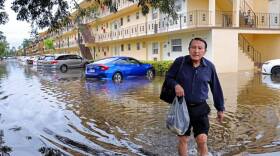-
The Southeast coast faces the threat of coastal flooding from the king tides. November's full moon will reach peak illumination on Wednesday.
-
Flash flood risk increases again for parts of the east coast of Florida, but the Panhandle will also experience some rain and a much-welcomed cold front arrives for the weekend.
-
The highest tides of the year are here for much of the week, and sagging fronts will continue to bring rounds of intense storms. Flash floods are possible.
-
Expect possible coastal flooding the next few days, along with king tides and high rip current risksIt's that time of year. As fall approaches. many of Florida's waterways are on the rise, which also means an increased risk for flooding and dangerous beach conditions.
-
High tide floods – when water collects in streets or even seeps into buildings on days without rain – are increasingly common in coastal areas as sea levels rise, a new report warns.
-
Parts of South Florida received 9 inches of rain, along with high winds that produced gusts of up to 70 mph.
-
Inside one of the biggest stormwater pump factories in Florida, 90 workers are busy molding metal: cutting, shaping, welding, painting, and assembling it into the massive machines responsible for keeping South Florida’s streets dry.
-
NOAA projects that the high tide flood frequency between May 2022 and April 2023 will average 3-7 days, the same as the previous year, but an increase from the 2-6 days expected between 2019 and 2020.
-
As attention and urgency ramp up around the world over the looming dangers of climate change, a major new federal report released on Tuesday offers a surprising forecast: It actually reduces the amount of sea level rise the world is expected to see as the Earth warms.
-
But neighborhoods 20 miles inland are starting to feel the impact, as the Atlantic Ocean’s higher elevation makes it harder for drainage canals to keep them dry.
-
St. Petersburg faces the highest long-term projection of flooding days of any of the 15 cities in Florida cited by the report.
-
St. Petersburg currently sees about seven high-tide flood events per year. But in a decade, researchers expect that number to soar to 67 per year.
Play Live Radio
Next Up:
0:00
0:00
Available On Air Stations












